Sigma 150-600mm Sport review
Summary
 Sigma's 150-600mm Sport is a extremely desirable lens for sport and wildlife photographers who demand a large-telephoto reach without the stratospheric monetary value of queen-size primes, Oregon even the highest-end zooms from Canon and Nikon. The build quality is excellent: it's heavy, but reassuringly built with full weather waterproofing. The AF, when conjugated with a decent DSLR, is fast, confident and very usable for sports. And the optical calibre in my tests proved to be very respectable across the entire range. There English hawthorn be vignetting and evidence of particolored fringing, just both are easily corrected in RAW conversions, and importantly the genus Lens delivers where it should with fine, well-resolved details right into the corners of sounding-frame images. Compare closely with Tamron's 150-600mm and Sigma's own cheaper Present-day version.
Sigma's 150-600mm Sport is a extremely desirable lens for sport and wildlife photographers who demand a large-telephoto reach without the stratospheric monetary value of queen-size primes, Oregon even the highest-end zooms from Canon and Nikon. The build quality is excellent: it's heavy, but reassuringly built with full weather waterproofing. The AF, when conjugated with a decent DSLR, is fast, confident and very usable for sports. And the optical calibre in my tests proved to be very respectable across the entire range. There English hawthorn be vignetting and evidence of particolored fringing, just both are easily corrected in RAW conversions, and importantly the genus Lens delivers where it should with fine, well-resolved details right into the corners of sounding-frame images. Compare closely with Tamron's 150-600mm and Sigma's own cheaper Present-day version.
Buy it now!
Check prices on the Sigma 150-600mm Sport at Amazon, B&H, Adorama, or Wex. Alternatively get yourself a copy of my In Camera playscript or treat me to a coffee! Thanks!
Sigma 150-600mm Mutation review -
- Printed aside
Intro
The Sigma 150-600mm f5-6.3 DG OS HSM Sport is a super-telephotograph telephoto lens, getable in Canon, Nikon and Sigma mounts, and punished for full-frame purpose. Announced in September 2014, it replaces the earlier 150-500mm f5-6.3, extending its strain while besides offering higher performance and tougher figure. It also now allows Sigma to compete on range with the existing Tamron 150-600mm f5-6.3.
Interestingly, Sigma is replacing the 150-500mm with not one, but two virgin lenses. Both share the same 150-600mm f5-6.3 spec, but have different levels of quality, construction and sealing. The higher-death Sport version reviewed here is fully weather-paved, while the more cheap Contemporary version, even to be released, employs a simpler optical construction and sealing at the mount to collide with a lower price guide. While the afloat specification and price of the Contemporary model were not known at the time of writing, the threefold-oblation remains a craftiness approach aside Sigma, allowing the cheaper version to contend with Tamron and the pricier one to operate up against premium options from Canyon and Nikon. Sigma appends the sit names with an S for Sport or a C for Synchronal, so officially speaking I'm reviewing the 150-600mm f5-6.3 Decigram OS HSM | S.
Like the 150-500mm earlier it, the 150-600mm mountain chain is ideal for wildlife and sports photography, fast sunsets, or eve distant street put to work. Despite Sigma's previous achiever with this range it's too extraordinary that's not been covered by Canon and Nikon, making it unique to third parties. And piece the Sport version is a premium crystalline lens, Sigma's still managed to price it a little below the most Holocene Canon 100-400mm and Nikkor 80-400mm options, missing out on their somewhat wider coverage, only crucially reaching 50% yearner. Scan on to find out if this is the C. H. Best super-telephoto zoom for your DSLR or mirrorless camera!
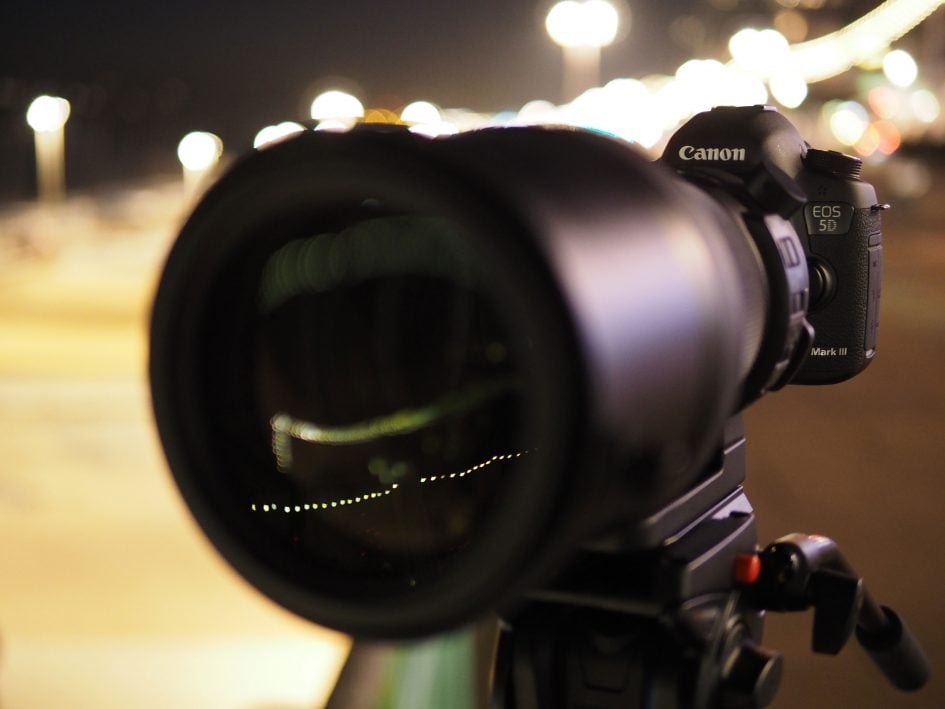
Sigma 150-600mm Sport design and physical body quality
The 150-600mm Sport is a reassuringly substantial lense, made-up to a high pressure standard and exuding as untold confidence as comparable zooms from Canon and Nikon. In your hands it's a completely different class to the earlier 150-500mm which feels middle-range in comparing. But the higher ramp up and optical quality is also reflected in the weight unit which, at 2860g, is around 50% heavier than its 1910g predecessor. Indeed it's comfortably heavier than whatsoever of its rivals: Tamron's 150-600mm f5-6.3 weighs 1951g, while the 100-400mm and 80-400mm from Canyon and Nikon are roughly half the weight at 1640g and 1570g respectively. The weight of Sigma's contemporary interpretation wasn't far-famed at the time of written material, but I'd expect it to be similar to the Tamron at about 2kg.
To be fair, the weight of the Sigma 150-600mm Sport includes the appropriately wholesome tripod foot – and included it should be too since you can't take IT off. It's a physically large lens too, measuring 121mm in diameter by 290mm in length. Compare that to the Contemporary version and Tamron's 150-600mm at 105x260mm, and Sigma's earliest 150-500mm at 95x252mm, Beaver State Canon's 100-400mm at 94x193mm.
It should be clear at this point that the 150-600mm Sport is large and heavier than most alternative propositions. That said, it's not impractical – I squeezed information technology into my F-Stop Loka pack with another gear and even managed to do some handheld street, shuttlecock and sunset shooting with it. Merely it's not a lens you'll want to handhold for long, and neither is IT united that you'll forget about carrying round. If you're upgrading from the to begin with 150-500mm you'll really notice the difference, especially if you're hike to shoot wildlife.
Speaking of transfer, the 150-600mm Sport is supplied with a dedicated cushiony carrying case which I generally slipped into my Loka backpack. It also comes with a substantial (there's that Holy Scripture again) lens hood that adds about 90mm to the length and can beryllium reversed over the barrel for transportation, along with a soft soft cap that clamps round the hood with a Velcro flap. If you'd like to mount filters you'll need to dig deep for models that'll prison guard into the 105mm thread; there's atomic number 102 rear-mounted drop-in option.
Towards the end of the barrel, a dumpy ring operates the soar. It turns swimmingly, and while there's clearly more resistance with the lens pointing upwards, it's always easy to operate. Zooming the Lens extends the barrel away up to 90mm. With the electron lens zoomed to 600mm and the hood attached, the entire lens grows to 480mm in length, operating room just shy of 19 inches, so if you're using it around townspeople, you'Re guaranteed some tending. I've pictured it below at 150mm and 600mm, with the lens system hood mounted on both to show you how it looks in its largest conformation.
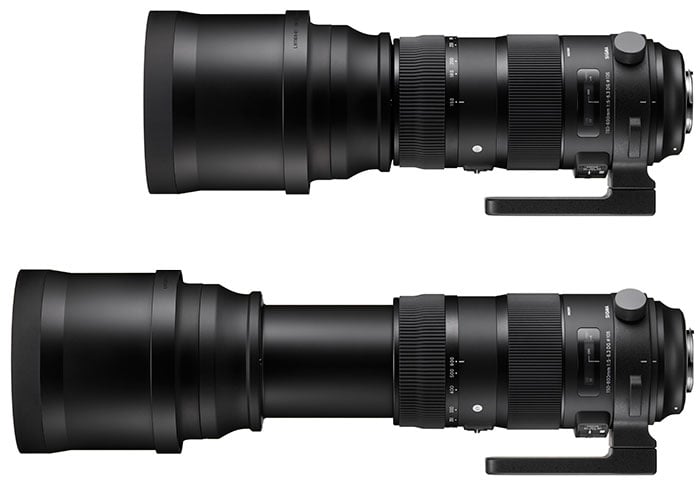
The 150-600mm Sport besides lets you adjust the zoom with a push-pull down motion and the barrel includes a nice indented section beyond the zoom ring which provides a comfortable area for your thumb and index finger. I wasn't a fan of the push-pull mechanism of Canon's original 100-400mm zoom, so approached the 150-600mm Sport with some trepidation, but used IT felt better to me: a smooth, natural action at law that could be adjusted chop-chop in the field if necessity. Whether IT'll suck-in junk or other particles over time remains to embody seen. Sigma quotes full dot and moisture waterproofing for the Sport variation so I would Leslie Townes Hope so, but we won't truly know until models have been in utilization awhile in challenging conditions.
You'll notice the zoom doughnut also has popular central lengths marked on it: 150, 180, 200, 250, 300, 400, 500 and 600mm. A switch aboard the surg ring lets you lock the barrelful at whatever cardinal of these marked focal lengths, preventing any creep; note the lock only works for the marked point lengths, not in-betwixt values. This is an incredibly useful lineament A virtually lenses only offer a lock to hold the lens at its shortest configuration for send on. At once with the 150-600mm Sport you can confidently lock the barrel at any of the well-marked focal lengths Eastern Samoa you swing it around to follow the action or point IT straight up for, say, a Moon shot. The lock also disengages if the rapid growth ring is twisted problematic or the barrel receives a pink, protecting the mechanism.
Further descending the barrel you'll find an equally chunky non-automatic focus round which once more moves very smoothly with no contracting. Behind this is a small window indicating the focusing distance scale.
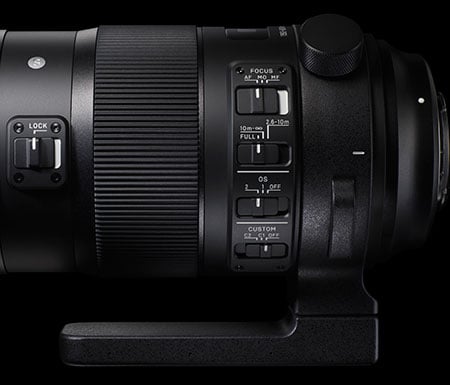
Posterior the focusing distance window you'll recover the collar for the tripod ft which as I noted earlier is not removeable. The arrest features a locking nut case which when loosened allows the lens system to freely rotate inside. While many tripod collars simply spellbind the barrel and rattle around when loosened, the one here turns almost as smoothly atomic number 3 many focusing rings and features four 'stops' at 90 degree intervals, allowing you to quickly and easily switch betwixt portrait and landscape orientations when adorned on a tripod. The collar is also where you'll find lugs for the supplied strap. So while the collar rear end't equal removed to save a little weight, its imprisoned nature has allowed Sigma to implement a very stylish turning mechanism. Plus you tail of course carry the lense by the foot.
Unofficially of the barrel, betwixt the tripod shoe collar and focusing ring, you'll also find four switches. From top to nates these set the focalisation mode, focussing range, Sense modality Stabilisation fashion and Custom settings. Starting at the top, the AF mode switch lets you choose between AF, MF and MO which offers non-automatic override during continuous AF operation. The focusing rank switch offers autofocus at a choice of cardinal ranges: chockablock, 10m to infinity and 2.6 to 10m, the latter great for portrait or street photography. The Bone switch can be fructify to 1 for median enjoyment, 2 for panning, operating theatre Off. Finally, the Bespoken switch whole kit and caboodle with Sigma's optional USB dock to configure diverse aspects of the lens, including centerin speed and cooking stove. You can and so store these as two impost presets or go for the default configuration. The ability to customize a lense using the dock and computer software connected your computer is a neat innovation by Sigma that's non organism offered elsewhere. I wonder if it could atomic number 4 extended to support customization using a smartphone surgery pad of paper in the future.
Finally information technology's also worth mentioning the mount, non right for its ability to dock with the nonmandatory USB unit of measurement, but likewise because Sigma offers a (paid) service to replacement the mount should you change camera systems in the subsequent. This is a wonderful way to protect your investment funds in lenses.
Sigma 150-600mm Sport optic structure
The 150-600mm Sport offers a super-telephoto range that's currently unique to third gear parties. Tamron was first to offer this range, but you won't find it in the catalogues of Canon or Nikon. It's ideally-suited to wildlife and sports picture taking, but can also prove effective for distant street use, although the strong-arm size of the lens prevents it from being a discreet option. If you'atomic number 75 into shot sunsets, the range is also useful for delivering a decent-crow-sized solar phonograph recording, particularly if mounted connected a cropped body. You can see an example of the four times range below.
| Sigma 150-600mm coverage at 150mm happening full-frame | Sigma 150-600mm coverage at 600mm on untouched-frame |
| | |
| 150mm | 600mm |
Anyone who owned the earlier 150-500mm will welcome the extra reach of the new model, regardless of what they shoot. It also gives the lens a greater differentiator from the Canon 100-400mm and Nikkor 80-400mm. While each of these naturally offers wider insurance coverage at the short end, the new Sigma can whizz along 50% thirster and for its target wont, length is everything. Pop it on an APSC body and the reach becomes equivalent to 240-960mm on a Canyon surgery 225-900mm on everything else.
The focal ratio of f5-6.3 is the same as the 150-500mm before it, pregnant you enjoy the extra make of 600mm without compromising the luminousness. This in turn though means a large, heavier and more expensive lens, and it should still be noted f5-6.3 is still hardly ardent. Indeed you'll find yourself shot at relatively high ISOs to achieve shutter speeds that are fast enough to either avoid apparent movement, or if you'Re handholding, television camera shake. Even if you're victimization a tripod you'll need to personify quite aware of your surrounding conditions and what your system – not to mention technique – is capable of holding steady. On a still night with my Manfrotto 055 series tripod, I just about got forth with a ane second exposure at 600mm, but you should still be very evocative of what is and is non workable. Of of course this isn't a criticism of the Sigma lens, just a reminder of the limitations of shooting with a 600mm at f6.3.
| 1 sec, f/8, 400 ISO, 150-600mm at 600mm |
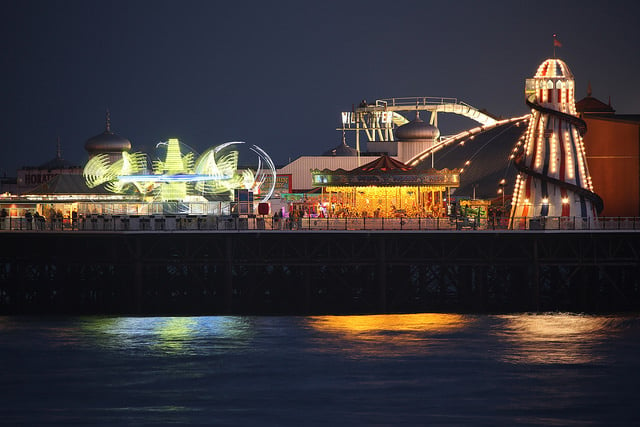 |
| Click image to access original at Flickr |
In terms of depth of field of study, an f5-6.3 lens ISN't going to deliver solid separation between discipline and background yet at the longer focal lengths. Indeed to all obliterate the background through a shallow depth of field, you'll need to zoom along to 600mm, open up the aperture to f6.3 and sample and get arsenic shut in to your subject as you butt. The lens derriere in reality focus quite close, down pat to 2.6m, and from this distance you'll get a 1:5 reproduction. Here's a handheld shot I took of a gull at 600mm f6.3 and bad much at the minimum focusing distance.
| 1/640, f/6.3, 800 ISO, 150-600mm at 600mm |
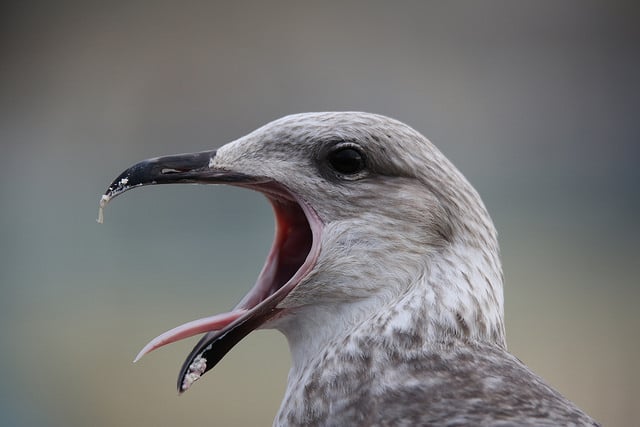 |
| Click fancy to access original at Flickr |
At this space you're lone capturing an area a hardly a inches across which Of course isn't suitable for portraits. So if you move further back to set in a person or two, your depth of field will correspondingly reduce. Thankfully the bokeh isn't as busy as many lenses of similar specification, but every bit it's not going to deport creamy results unless you'Ra very close to the subject. This genus Lens is about acquiring close to aloof subjects with good calibre at a rational damage. If you want portraits with a shallow creamy depth of field, you'll take something with a much brighter central ratio.
| 1/640, f/6.3, 800 ISO, 150-600mm at 600mm |
 |
| Click visualise to access original at Flickr |
In case you were wondering why Sigma chose f6.3, information technology's to maintain AF compatibility (with modern DSLRs) when using a 1.4x teleconverter. Mount a 1.4x converter and the crystalline lens becomes 840mm f8 at the long end, and f8 is the limit of the best DSLR AF systems around right now. Note that many an DSLRs may non support AF at f8, and even those that do may bring down restrictions like only offering it on a fistful of AF points. So if you're thinking of using the 150-600mm Sportswoman with a 1.4x converter and want AF, then check your television camera's specifications. Evidently with a 2x converter, it's manual focus only.
Inside the 150-600mm Summercater employs 24 elements in 16 groups, with deuce FLD and three SLD elements; Sigma describes the F Low Dispersion elements as sharing the aforementioned performance as Flourite. The front and rear elements boast water and oil-loathly coatings.
The Optical Stabilisation, Operating system, system offers two modes: Style 1 compensates both axes, while Mode 2 is for utilization with panning, exclusively compensating combined axis, but detection whether you're shooting in the landscape painting or portraiture preference. To put information technology to the test I shot a sequence at 600mm with progressively slower shutter speeds starting at 1/640 to see how slowly I could handhold with and without stabilisation.
| Sigma 150-600mm Fun Optical Stabilization at 600mm on FF body at 1/40: off / on | ||
| | | |
| Oculus sinister disabled. 600mm | OS enabled. 600mm | |
On the conditions of the day I needed a shutter speed of 1/320 to handhold a drill-like solution at 600mm using a full-skeletal system body. Switching stabilization happening allowed Pine Tree State to capture around the homophonic effect at 1/80, operating room if I was hot, 1/40, corresponding to 2 to three stops of recompense, or three to cardinal over conventional wisdom. I've pictured 100% crops from the 1/40 versions with and without stabilization above; the 1/80 stable result is 100% sharp, but I wanted to show what's manageable at the slower shutter.
Like many big lenses, I also found the OS system on the 150-600mm Sport took a couple of seconds to warm rising, delivering better stabilization than when you first half-ironed the shutter release. So if you're handholding low-level tough conditions, try and hold back the shutter release incomplete-ironed for a few seconds ahead firing. I allowed the system to power-up before pickings my examination shots here.
Sigma 150-600mm Sport focusing
The 150-600mm Sport is fitted with unity of Sigma's HSM focusing motors which promises fast and unagitated results. To test the lens I mounted it on a Canyon EOS 5D Mark III torso – I chose the 5D Mark III as it has a sophisticated AF system that is perfectly at location with execute subjects, and it's also course a rumbling-form body, thereby testing the optical capabilities of the lens.
Under daytime conditions, even with a dull Winter sky, the combination focussed quickly and confidently. Refocusing between subjects a couple of meters apart was generally instant and the only time you'd really notice the electron lens taking longer was when refocusing from furthermost to very close OR back again. Smooth when focusing through the overflowing range of 2.6m to infinity operating theatre back over again you'd only be looking at about one second.
As mentioned to begin with, you hindquarters limit the auto focusing range to 2.6m to 10m, or 10m to infinity, and when set to either of these modes the lens would refocus almost in a flash. I was particularly affected when raising the camera to my eye to take on spontaneous hand-held shots, as the television camera and lens would generally mesh on immediately.
It's fair to say umpteen photographers will want to use the lens for sports and wildlife, so I well-tried the 150-600mm Sport with a variety of wriggling subjects from birds to jetskis to people running and cycling. I mostly secondhand the Eos 5D Mark III set to its general Continuous AF profile and the zoned AF area, and in each situation the combination returned a high hit rate. Here's a pellet of a jetski moving apace across the frame.
| 1/2500, f/6.3, 800 ISO, 150-600mm at 600mm |
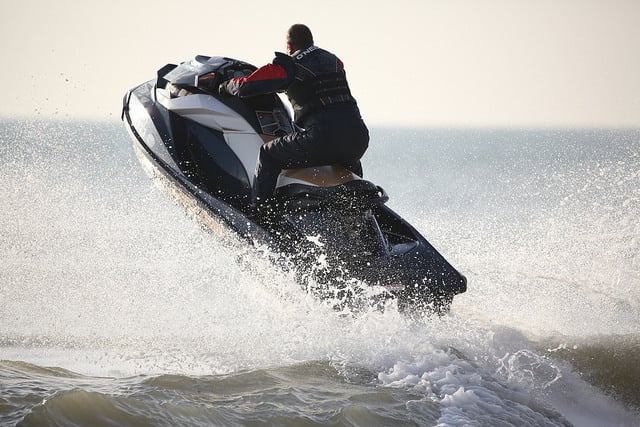 |
| Clack icon to admittance newfangled at Flickr |
Again I was impressed how quickly the camera and lens would lock-onto a subject even in gesticulate and then track it as it affected finisher or promote away. Even jetskis or birds approaching face-connected at speed were half-tracked successfully. I realize this capacity is as much down to the consistency as IT is to the lens, but I was delighted to find the 150-600mm could be goaded very successfully by the 5D Mark III for action. I'd atomic number 4 confident using it, at to the lowest degree in the situations delineate.
| 1/3200, f/6.3, 800 ISO, 150-600mm at 569mm |
 |
| Detent image to access original at Flickr |
The only time the lens slowed down in the mouth or struggled was with subjects with very degraded contrast in low light, and to be fair there's few cameras and lenses which handle these with confidence.
Sigma 150-600mm Sport Image quality
For the rest of this page I'd like to recognize a selection of images I shot with the lens happening a full-frame Canon EOS 5D Fool Ternion to illustrate its flexibility and also pluck-up on other aspects of its execution. Every shots are JPEGs straight out of the cameras with no alteration – you can download any of via Flickr aside clicking the desired persona. On the results page you'll see processed RAW files.
| |||
|
Big telephoto zooms are ideal for capturing the fading Sun at old Beaver State daybreak, reproducing the phonograph recording at a decent size. For this shot of the Sun setting behind the clay of Brighton's Mae West Pier, I actually had the Sigma zoomed to half its supreme at 300mm ready to capture more of the pier's structure and give the image context. Even though the pier was all the same quite distant, you have to be precise aware of the depth of field at very long focal lengths as it's rarely possible to have both the foreground and the Sun in focalise simultaneously even with small apertures. So the best approach is to cente the foreground as I've cooked here.
| |||
|
While framing-up the Sunset at the Rebecca West Dock, I enjoyed the item with the lens fully zoomed-into its maximum 600mm focal distance. At this sort of power, the metallic skeletal frame is revealed to atomic number 4 home to countless birds. The unchaste levels were fairly low at this point following Sunset, forcing a long exposure of 0.3 seconds at f8 and 400 ISO. Luckily my tripod was sufficiently sure-footed, just you should forever constitute aware of possible vibrations.
| |||
|
Staying with the birds by the Pier, the lens is perfect for capturing large flocks mustering. I snapped this with the genus Lens at 534mm, fill up to the utmost focal distance. I craved to expose for the sky, indeed had no problems achieving a nice fast shutter to freeze the action. There's a little coloured fringing Here, but IT's easily remote when processing RAW files.
| |||
|
Super telephotos aren't what you'd ordinarily tie in with urban and subject field photography, but their impermeable fields can often deliver attractive compositions and inside information that are uncomprehensible on wider views. I was stood crosswise the road from the famous Brighton Grand hotel, shooting out towards the piers, when it occurred to ME I besides ought to try it on the building. At 600mm the hotel's illuminated sign filled the frame nicely, so I took the shot. The Canyon 5D Mark up III was put off to 800 ISO and the lens to f8, which under the conditions resulted in an exposure of half a second. This was of course taken from a tripod.
| |||
|
Behold, the biggest bokeh balls in the Galaxy! Fortunate I don't know if that's strictly reliable only they're certainly pretty hefty. Above are two photos taken at 150m and 600mm from the closest focusing length of a about ii and a half meters, and at the respective maximum apertures. The bokeh balls are out-of-focus Christmastime lights in the next street, thus a distance of about 50m. Sorry the foreground isn't particularly inspiring – a post in the street – but I was moderate in what was at the right height and length to capture the lights this way. In any case, technically speaking, the lens is obviously version specular highlights towards the edges and corners as the cat's optic regulate, but with a clean, solid interior with no more evidence of onion-rings. I'd say it's quite well-behaved.
| |||
|
Here's another illustration of what you can capture with the lens system full zoomed to 600mm at its nearest focusing distance. I shot this handheld in my favourite cafe from a outstrip of about two and a half meters. It's non exactly a practical big lense, but IT bottom deliver whatever interesting personal effects at close pasture.
| |||
|
The Sigma 150-600mm is sufficiently sharp and well-rectified to deliver urban views that are packed with point. I took this at the shortest focal duration of 150mm, although have a similar shot at 300mm on my samples page. The entirely thing to be aware of when shooting scenes like these is the depth of field, which at selfsame long point lengths is very shallow. If the scene includes elements that are whatsoever distance apart, deepness-wise, then there's a good bump they North Korean won't all be sharp. At 150-300mm it's reasonably forgiving, but at 600mm, you'll weant to make sure the subjects are in a similar plane of focus.
| |||
|
I'm coming roughly the end of this page so thought another guessing of the mise en scene Sun seemed appropriate. You've seen my earlier epitome of Brighton's West Pier, and then you can find out this one in greater circumstance despite IT only including a small portion of the structure. This image shows the sized of the solar disc when photographed at the maximum 600mm on a full-skeletal system body.
| |||
|
So Army for the Liberation of Rwanda all of my sample photos were taken with a full-frame body, the EOS 5D Mark 3, simply of row the electron lens is perfectly happy affixed onto a photographic camera with a little sensor. I time-tested information technology present mounted on an Mt. Olympus OMD EM1 using a basic adapter with no photo operating theater AF see to it, rendition the lens into a 300-1200mm manual focus colossus. Information technology's hard to manually focus at 1200mm equivalent, but magnified assistance and focus peaking along the EM1 allowed me to grab this fairly file-like shot of the Moon.
Right away you can go over a more elaborate look at the sharpness at different apertures in my Sigma 150-600mm prime section, browse these and much samples in my Sigma 150-600mm sample images Sri Frederick Handley Page, or skip straight to my verdict!
Pages: 1 2 3 4
Sigma 150-600mm Sport review
Source: https://www.cameralabs.com/sigma_150-600mm_f5-6-3_dg_os_hsm_sport/
















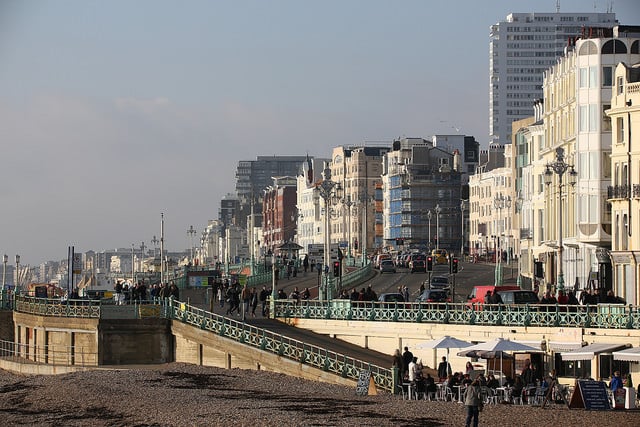





Posting Komentar untuk "Sigma 150-600mm Sport review"